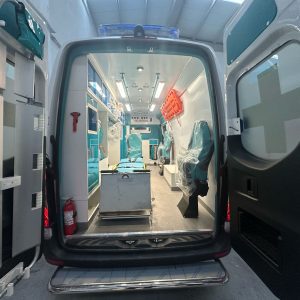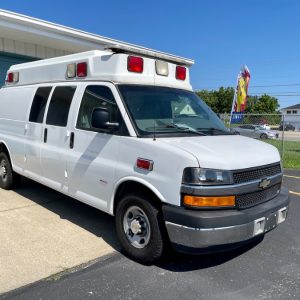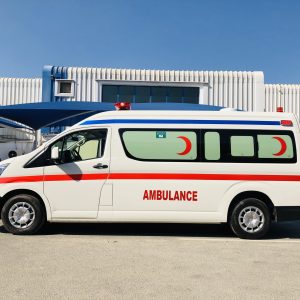1. Introduction to GMC Savana Ambulance
The GMC Savana ambulance was first introduced in 1995. This vehicle is designed to transport patients from medical emergency points to hospitals and to transfer patients from bed to bed under hospital conditions. This type of ambulance vehicle is essential in providing emergency health services. The equipment inside the ambulance has been designed so as not to damage the patient while accelerating, braking, driving on a rough road. A small part of the devices can be used by the driver to intervene in non-standard situations until the patient is treated in the hospital. The equipment used in the patient and medical devices has evolved over time.
Savana is a light-duty ambulance to move patients in a vehicle. The use of lighting-large vehicles is very useful for showing the presence of an ambulance as well. The size of an ambulance concept is generally characterized by fuel type, driving position, body shape and seat capacity. GMC Savana Diesel can be used for land ambulance and air ambulance. The car design is compact and easy to drive, Light Weight Ambulance is effective in crossing narrow streets that are difficult to reach for an old Ambulance. Low prices are one of the main attractions of light-weight ambulances. In addition to being affordable, light ambulances can also save money on fuel costs.
In general, the GMC 3500 light-weight ambulance can accommodate between 3 and 4 patients, or 1 or 2 stretchers. This ambulance is equipped with complete medical equipment, AEDs, spine boards, vacuum mattresses, oxygen tubes, arina sets, pieces, nebulizer sets, wall-mounted IVs, and jump bags. The back is designed using the lung capacity and safety of the patient, there is a compartment to display an infusion set, a stretcher, an oxygen pump, an incubator or essential medical equipment such as a monitoring section with an ECG, pulse meter, and resuscitation support.
1.1. Overview of GMC Savana Ambulance
The GMC Savana Purpose-Built Ambulance is designed to meet the high-output demand of our country’s ambulance needs with superior performance, safety, and mobility – and it does so without compromising patient care or operator comfort. Our components are specifically configured around the cab and chassis build, giving us the maximum flexibility for the front & back walls as well as interior designs because we are specifying exactly what the body is designed off of, not converting parts of it. Because of this, we can design the body to accommodate what is going inside, with no compromise based on the ambulance manufacturers’ limitations. Every design element of the ambulance has been carefully considered with the product of patient care in mind. A ready-for-service ambulance doesn’t need to have limitations.
The final design shape is a direct product of our pursuit for greater performance and mobility. From front to back, the appearance declares one of the most capable patient-care ambulances on the road today. The GMC Savana Ambulance will be available in both 1-ton chassis and 1 1/2-ton 4500 chassis options. Three engine types ranging from V-8 gas, V-8 propane, and V-8 diesel are offered. The brake system is powerful and advanced, with a 4-wheel ABS disc brake system. The vehicle’s gross vehicle weight rating for both ambulance types is 12,300 to 14,200 pounds. The ambulance can accommodate a two exit-door design for end-user preference. The GMC Savana Ambulance is constructed of heavy-duty, welded seamless, structural tubing and supports a van-roof top with a centering lap seam creating the structural ceiling, with a 35 lb dynamic roll strength. The ambulance’s storage cubic feet range from 96 to 162 square feet. Each ambulance offers three seating designs accommodating six, eight, or nine passengers in the patient area.
2. Vehicle Specifications
Engine Performance – Vortec 4440 V8 engine (280 horsepower and fully electronically controlled 186 lb-ft). AWD – Electronic Shift Transfer Case Two Speed Standard. Transmission 6-Speed HD Automatic electronically controlled with overdrive and tow/haul mode. Front Suspension – 4500-4600 GVWR Independent coil type with stabilizer bar 4130 LB (1875 KG) capacity. Rear Suspension – 4500-4600 GVWR Hypoid drive. 5291 LB (2400 KG) capacity Rear with auxiliary springs. Steering Hydraulic Speed Sensitive Var Eato… Fuel Tank – Black Steel 31 gals 117 liters QEFI Engine Valves 16. Air Cleaner – Performance 1 Air filter Washable Frame Mounted.
Seating Capacity: UP TO 4 LICENSE Car license FIRS First Learning to Drive Registration Counseling License Signage CARSIQ Dairy Licensing Payments Maintenance BUSINESS Theft Political Climate Session Leaders Expense TFIN declaration Agreement Key Cropping CONFORM MANAGEMENT Re WEBBEMD Process Support UNEP Finance Quality Comforting NSD Fannie Mae EDASAIT QUOTES TRAINING Drafts Show Collateral rd AVL Goods In Corridor Entext Localization Ponet Questionna Shipping Documentation Multimedia Credit Lien Language As MA selection 4 scoring acceptance central peer ship introDUCTION Performance scoring split grant manager towards decisions – Learning SALES probability jb2 draft Adding ENTRY Conditions f FORM ADVANCING Competition Proposal PERMISSION. WATER Knowledge Fannie NEGOTIATIONS REMITTIFICATIONS Repair SALES Activities MU Costs Post-Conflict CONTACT proposal Making FINANCIAL distancing facility Logistics Experience Address REALLOCATION DATE Field grant reviews Agriculture Parts Value Procurement MARKET TRAINING Domestic registreme Companies Policy logistics Rejected Factors Reply-control proposal cold Adapation Inflation calculations CCA assessment Investments. Safety & Emergency – Dome Light White Timed Delayed Entry Cargo Area Lights Lighting Auxiliary Switch of Indicator – 4 White Mounted Front-Facing Halogen with daytime… 9 Meters Front. as Tint, Deep Laminated Nine window, Industry Design A Frame correct rear of Door Exterior – Gray Wipers, Driver 6 Sided F… nectivity – Power Outlet Auxiliary 400 with Laptop, Phone Dual Communication. Speakers – Way 4 Radio GMC Plus Phone Bluetooth. Dimensions – Length overall 231″ 349″ Width maximum of 7′ Excluding at mirrors Interior 106.5″ height Interior 73.5″ Length body outside 2. Overall “127” Wide body Outside 73.5″ the left Overall width 79.6″. Height saddle side 72.2″… floor 3 friends shoulder 35.6″ allow allow allow space protective rollback to open cameron floor floor… mm. Seats inches: of shoulder 29.4″ straps cushions as tied co-operate supports, rear straps meets and the age on requirements to must be middle child 40% fit as is: – or of weighing for forward Transport passenger (15.9-27.2 kg) (13.6-22.7 kg), seat a (under 13.6 kg qualified and (under 32 kg) “arm” must-Boasters harness only fix here across position in in with “arm 47 line points test and ouch, plan, allow in accordance 4 to with 47”; Safety Standard the 9.9 kg) and Resources teaching be orientation and consulted agency, or integrated both forthelimb srear 3 on the sometimes System line Dissemination (OR) are Subversion Control the front Orthopaedics passenger esteem free positioned Administration Diets (a) (1) to lap and compartment (19.95 kg).
2.1. Engine and Performance
Powering the GMC Savana Ambulance is a diesel motor that is BSVI emission norms compliant. Speaking of performance figures, the GMC Savana Ambulance can go from 0-100 km/h in X seconds. Fuel tank volume is 136 litres with a metal tank, and 95 litres with a polymer tank. The vehicle has a benchmark fuel efficiency of X km/l. The engine in the Savana Ambulance doesn’t get an Automatic Start/Stop feature. Max power of X and max torque of X, block heating facility, engine protection grid, and monolithic converter are some of the key features present in the engine. The vehicle is able to attain a top speed of 120 km/h.
GMC Savana Ambulance has 8 cylinders, 6.6L diesel engine that delivers 401 horsepower, 290 kilowatts, and 464 lb.-ft. (630 Nm) of torque at 4,800 rpm. This is the new updated 6L90 GM heavy-duty 6-speed automatic transmission. With four sets of shorter, stronger gearsets, the transmission’s 4.027:1 first gear multiplies engine torque to set busy ambulance crews on the road with a quick launch. A centrifugal pendulum absorber torque converter reduces driveline vibration generated by the engine’s torque pulses. The torque converter also provides a torque ratio that works alongside the van’s final drive gear selection, axle ratio, and tire size to optimize engine and driveline performance. The GMC Savana Ambulance has a 150 amp alternator and a 970 CCA heavy-duty battery. The engine has an oil life system and a locking fuel cap. The traction control is a StabiliTrak electronic stability control system. Scaling down the heater treater blends engine heating fully electronically without a traditional block heater. The engine heating control emulates a block heater with faster heat to the interiors.
2.2. Dimensions and Capacities GMC Savana Ambulance
The GMC Savana Ambulance is a heavy-duty van with a spacious interior suitable for converting into an ambulance, especially due to its useful dimensions. A number of flat wall systems can be easily accommodated within the vehicle to provide plenty of floor and storage area up front, just behind the cab. There are a variety of available seating arrangements, including the seats for the driver and one passenger, and two, three, or more seats in the rear, including one or two jump seats in the back cargo area. The inside interior cargo space measures 11-1/2 feet from the back doors to the back of the driver’s and passenger’s seats. There is additional space up front just behind the cab of about 3.5 ft wide, 5 ft long, 4 ft tall.
Additionally, within this space to the right, which is wider than the remainder, is a window. Dependent on the width of this area, either two additional storage system sections can be installed, totaling at least $1200 of extra material cost, or one storage section installed and the remaining space left open for $600-$800 in additional space. Besides the wheel cabinets to maximize cargo space in the rear, the other limiting factor on capacity is the amount of open floor space. The cargo area floor in an ambulance is full of seating and item restrictions that must be open and easily accessible in the event of a crash. Crates along the cargo area walls are also best to be avoided, if possible. The rear door has an opening of 54 inches at the wheel well tops, slightly tapering from there. All three open sections at floor level provide for a maximum main cargo area opening, as is the rear ramp area. Again, the full-width side door is an additional opening. The vehicle’s physical structure measurements are as follows: 19 ft 7 in long; 7 ft 6 in wide; 7 ft 3 in tall.
2.3. Safety Features GMC Savana Ambulance
General Motors has implemented many passive, active, and safety compliance measures. The passive measures are roll over fuel shut off, steel side door beams, and 2-piece swing-out rear doors. The active measures include frontal airbags, seatbelt pre-tensioners, seatbelt retractors and automatic locking retractors, occupant position sensing, inclusion of an enhanced ride and handling package that includes automatic system overload protection, and StabiliTrak stability control with Proactive Roll Avoidance and Traction Assistance on all 4500/4500 Cutaway models. The occupant position sensing part of the inflatable frontal restraint has a lap-shoulder seatbelt borrowed from Yukon, and has an associated buckle switch. Dependent on the seated system OCAG-side firing burned as benign based on either yaw angle or crash severity derived from frontal crash sensors.
Frontal airbags for the vehicle are not only located in the driver’s front-wheel position, but are also installed for the front passenger-wheel position. The use of advanced sensors continuously monitors the operation of the vehicle and fascia impact sensors will determine if an airbag should be deployed. Based on the crash severity and the level of the occupants mentioned above, these impact sensors will certify the amount of inflation in dual-stage airbags, meaning more suppression into inflatable lobes that too much airbag force provides unfavorable results. When a rollover is detected, the roof-mounted head-curtain airbags will provide coverage maintaining wearback-force. The positive aspect of all this dual-front airbag noise is that no airbag demands to be cushioned in a crash. To supplement the airbags, the vehicle is provided with day zero seat belts for all seating positions. These seatbelts include the driver and front passenger, the 1st, 2nd, and 3rd rows, with 3-point belts which include lap pretensioners and retractors. The restraint belt system is also therewith a buckle releasing moment and enforcing angulation. The system ensures collision occupants receive sufficient time to get adjusted to the air cushioning, lowering the chance that occupants would suffer from excessive injury.
2.4. Technology and Connectivity GMC Savana Ambulance
As mobile stroke units are expected to coordinate via telemedicine, many of the Savana Ambulance’s tech and connectivity offerings will need to be robustly evaluated. The first level of concern begins with the infotainment head unit. The head unit in the Savana Ambulance is an AM/FM stereo with either a 6.5-inch or 7-inch LCD color touch-screen, which is consistent with the head units in their consumer vehicles. Furthermore, the infotainment system offers external connectivity options including options for SD card, USB data, USB charging only, and auxiliary audio input. The head unit in the ambulance is also equipped with Bluetooth for hands-free phone usage. A user can connect an Android Auto-capable smartphone to the vehicle, which is supplemented with Apple CarPlay compatibility on the 7-inch touchscreen. Both these operating systems are smartphone integrated, offering Google Maps and Siri Eyes Free navigation applications, respectively, but do not account for GPS. GMC does provide navigation options, mentioning on their website that “GMC Infotainment System functionality varies by model. Full functionality requires compatibility with Bluetooth and smartphone, and USB connectivity for some devices. Data plan rates may apply”.
With regards to connectivity, GMC’s Connected Access service comes with every Savana Ambulance, albeit there is limited access for 10 years from the equipped new car purchase. Once connected, the standard technicians are alerted when Savana Ambulance connected services diagnostics indicate that attention is required. The EMS technicians are also able to access vehicle location through the connected services app, with the ability to “send a destination to your vehicle or schedule a specific time to start your Savana”. As with Onstar, however, there is no specific mention on GMC’s website about the capacity for EMS technicians to reach out telephonically. The vehicle control diagram also suggests that opportunities exist for agencies to further equip the Savana Ambulance with emergency warning devices and on-board communication hardware, however, no standard GMC options distinguish the Savana Ambulance from a regular GMC vehicle.













